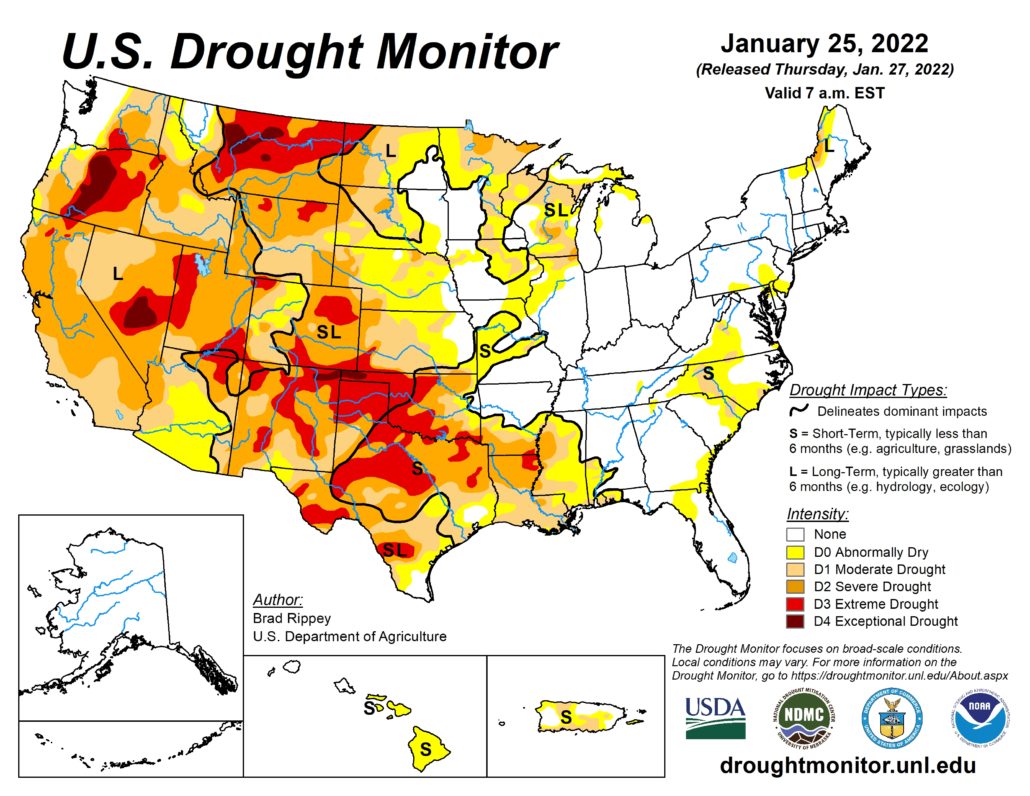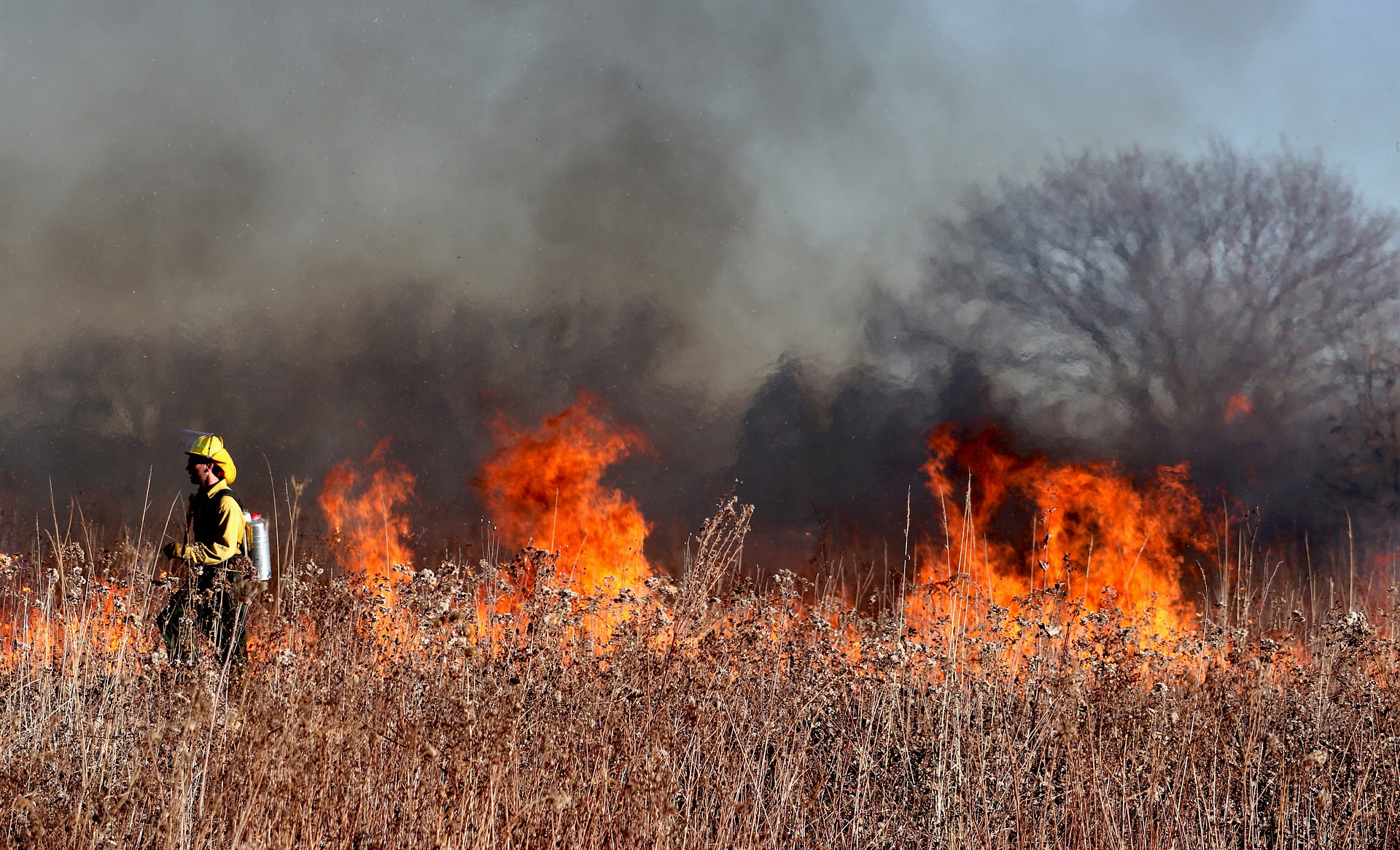Below are summaries from the National Significant Wildland Fire Potential Outlook, provided by the National Interagency Fire Center, for the period of February 2022 through May 2022. Additionally, the full outlook can be located here.
Observations in January:

United States and Puerto Rico Author(s): Brad Rippey, U.S. Department of Agriculture
Nearly 90% of the West remains in drought, with most of the Plains and Texas also in drought. Most of Texas and the Lower Mississippi Valley saw an expansion or exacerbation of drought as well. Temperatures were below normal across much of the central and eastern US and generally around normal in the West. Much of the West had a dry January, but snowpack is mostly 75% to 125% of average. Above average precipitation across the Carolinas and Virginia reduced drought and fire potential concerns, while most of the Plains and Great Lakes observed below average precipitation.
Weather Outlook for February – May:
Climate outlooks through spring indicate near to below normal temperatures and near to above normal precipitation are likely across the northern half of the West into the western Great Lakes. Above normal precipitation is also likely across the Mid-Mississippi and Ohio Valleys and through much of the Great Lakes and Northeast into the Mid-Atlantic. However, drier than normal conditions are expected for the southern half of the West, southern and central Plains, and portions of the Southeast, with near to above normal temperatures likely as well across these areas. Guidance also indicates this could be a potentially busy severe weather season east of the Plains, which usually portends to periods of critical fire weather conditions on the Plains behind the severe weather.
Wetter and colder than normal conditions are likely for the Northwest. Additionally, near to below normal temperatures and near normal precipitation is forecast for Northern California. Subsequently, drier and warmer anomalies are likely by early spring for Northern California. Similarly, Southern California will experience below normal temperatures with near to a little above normal precipitation from January through April. Forecasters predict the Northern Rockies to experience above normal precipitation through March, with cooler than average temperatures. However, near normal temperatures and precipitation are expected across the Great Basin, with the exception of Idaho likely to experience above normal precipitation.
On average, the Southwest can expect dry and mild conditions through the outlook period. Warmer and drier than average conditions will continue for southern Colorado, Nebraska, and Kansas. Contrarily, northern Colorado, Wyoming, and South Dakota will continue to receive cooler and moist weather through April 2022. Additionally, above average temperatures are forecast for the southern area of the Eastern region through March 2022. On the other hand, below normal temperatures are likely for the Upper Midwest and Mississippi Valley in March and April. Through April, most of the Eastern region is expected to receive near to above normal precipitation. According to climate outlooks, the Southern Area can expect above normal temperatures and normal to below normal precipitation through the outlook period.
Fire Potential Outlook for February – May:
Above normal significant fire potential is forecast for much of the central and southern Plains through March while persisting on the High Plains and eastern slopes of the Front Range through April into May. Above normal potential is forecast in portions of south Texas and the Hill Country during February then spreading across far southwest Texas, much of New Mexico, and southern Arizona by May. The westward retreat of above normal significant fire potential in Oklahoma, Kansas, and Texas is following the expected green-up procession.
Due to the recent widespread and in places, heavy precipitation across the Carolinas and Virginia, forecast above normal significant fire potential was removed in February. However, above normal significant fire potential is forecast in portions of the Florida Peninsular into southeast Georgia in February and likely persisting through the spring. Additionally, above normal potential is likely to expand across Florida and into the Carolinas during March and April. Lingering above normal potential is forecast to remain across Florida in May. Areas of south and east Texas into the Lower Mississippi Valley will continue to be monitored for above normal potential.

Febuary 2022 – Significant Wildland Fire Potential Outlook

March 2022 – Significant Wildland Fire Potential Outlook

April 2022 – Significant Wildland Fire Potential Outlook

May 2022 – Significant Wildland Fire Potential Outlook
Source: NIFC





One Comment